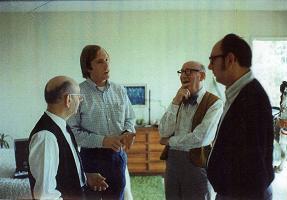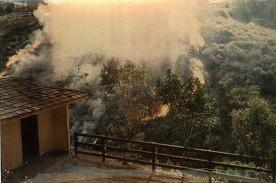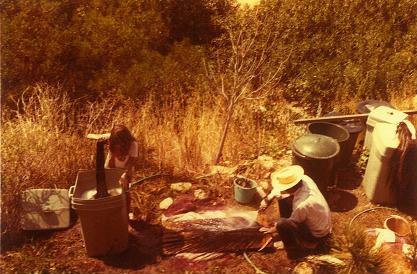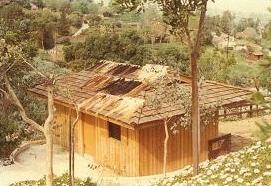|
Carousel carvings
are now a treasured art form, an active focus of preservationists,
museums, historians and collectors. It is hard to imagine that
carousel operators once trashed their wooden horses and menagerie
animals, burying or burning them in favor of homely, lower
maintenance aluminum castings. And nobody seemed to care. A number
of factors coincided to create a revolution of consciousness. One of
those elements was the Flying Horses catalog.
|
The first shot in
the revolution was fired by New York City historian Frederick Fried
in 1964. His
A Pictorial History of the Carousel
chronicled
the robust development of carousel manufacture in the U.S., giving
identity and artistic stature to such formerly anonymous carvers as
Charles Looff, Daniel Muller, Salvatore Cernigliaro and Marcus
Charles Illions. Fried’s scholarship also conferred stature and
encouragement to legions of closet carousel fans who discovered they
were no longer alone. |
 |
Jo was one of those
fans, though she was much less isolated than most; she had a
lifelong motivation and a five year jump start into outreach and
research prior to Fried’s contribution. The image of her beloved
horses, turned to cinders by the overnight conflagration of the Long
Beach, CA, Looff machine, had burned as an unquenchable flame into
her ten-year-old soul. That smoldering trauma was both quenched and
rekindled when Rol presented Jo with a little horse for their second
wedding anniversary in 1959. Jo scoured the informational wasteland
that summer trying to find any clue to the origins of wooden horses.
She learned eventually that their horse was German but that,
contrary to popular myth, most of the carvings in this country were
not. The most interesting merry-go- rounds, with the most
diverse and creative styles of carving, were made in the U.S.A. But
where, and by whom?
The answers came in
the book. More answers and intriguing new questions emerged
from an exciting 1966 visit to Fred and Mary Fried in their
Manhattan townhouse. Thanks to the book, Jo and Rol had already
developed a particular interest in M.C. Illions. Now they learned
that Illions’ son, Rudy, lived a stone’s throw from Rolling Hills in
Ocean Park, California. They sought Rudy out at his Looff carousel
in Pacific Ocean Park. He was distrustful of their intense interest
at first. Carousel fans and carousel families were equally estranged
back then, sort of like townies and carnies. “What makes these kids
want to pry into our family business?”
|

M.C. Illions on his horse "Bob". Illions
favorite was used for both racing and carriage. |
|
The mutual trust
and respect that emerged during the repeated visits with Rudy
Illions, then with his family and soon with his younger brother,
Barney, became typical of other alliances that emerged in the
carousel revolution: “Cerney” (Cernigliaro) and his daughter,
Marguerite, and, later, Bill and Marion Dentzel. These alliances
helped to restore dignity and pride in an artistic and cultural
heritage which had become obscured and even demeaned over time. |

Three generations of Illions: Rudy, grandson
Phil
and son Joe. Barney Center.
Rolling Hills, April 1, 1973. |
The young couple’s
quest to find an Illions horse for sale led them in 1969 to Marianne
Stevens, a no-longer-closeted fan in Roswell, New Mexico, who had
tracked down and purchased a group of fire-damaged horses from the
Illions Coney Island Boardwalk machine (the site eventually occupied
by the Flushing Meadows-bound Stubbmann carousel). They struck no
deal but the relationship struck oil. Jo and Marianne would get
together and pore over hundreds of photographs, learning to identify
almost any carousel figure by the subtle hallmarks of individual
carver styles. Those photo flash cards came from the travels of
Marianne’s friend Gray Tuttle, a South Carolina carousel operator
and dealer.
By 1970 this small
group of carousel afficionados was poised for direct assault on the
wasteland of public indifference. But each knew of only a few others
who could share the cause. There was no organizing medium, no
rallying cry, no roll to call. Enter the Flying Horses.
In the early spring
of 1970 Jim Wells, an antique band organ dealer in Fairfax, VA,
advertised some carousel horses for sale in Amusement Business
magazine. He claimed they were Illions, though Jo couldn’t quite
recognize the sample photo he sent of a particularly handsome horse
with a “needle” nose, deeply rippled mane and alertly pricked ears
(the flash cards had not discovered that rare, early Feltman style,
nor was it evident in the Fried “bible”). Whatever it might be, Jo
fell in love with it. Armed with a newly-arrived tax refund Rol flew
overnight to meet Jim on April 18, leaving Jo, excited and envious,
minding the home front with the four young children.
|

The sample/signature horse at Jim Wells' (in
front of a Stubbmann organ). |
Jim proved to be an engaging and persuasive
salesman. He advised Rol to check out the
former World’s Fair carousel in Flushing Meadows to verify the
concordance with his stock. The whirlwind shuttle to New York made
Rol a believer. And Jim’s horses, despite their sometimes-shattered
condition and the dingy environs of their semi-trailer stables,
suddenly shone with a new luster. Here was the chance to buy not
just one Illions horse, but dozens of them! And a bunch of Looff
carvings, to boot. Rol scrounged around for additional funds and
bought the lot.
|
The arrival of a
Bekins van full of blanketed horses caused quite a stir in the rural
suburb of Rolling Hills, or at least the brush fire did. Under
ordinary circumstances 50 horses would have remained out of public
awareness, all spread out to be washed and inspected in the hollow
beyond a long, steep driveway. But suddenly the brushy hillside
directly across the canyon crackled into roaring flame. The fire
dispatcher Jo phoned in alarm insisted on listing the Summit’s
address, despite Jo’s passionate attempts to direct the response to
the street on the other side. Sure enough, the engines clogged the
street and fire crews grunted up the driveway with bulging hoses,
only to find a bizarre but tranquil horse laundry. Their hasty
turnaround ran counter to the tide of neighbors streaming up the
drive, equally unprepared for the surreal scene at the top. |

The fire |
|

After the fire (Jo holding
Sheri along with neighbors)
|
After the fire was
quenched and all the looky-loos had dispersed, there finally was
time to go back to inspecting the carvings, released now from their
years of accumulated grime. Rol noticed a mysterious pattern on the
off-side saddle blankets of some of the Feltman horses, little
nubbins of something distorting the thick smoothness of the
overlying paint. The bumps turned out to be hinges and latches for
hidden interior access doors, which Rol could open only when he
carefully chipped the margins free of dozens of layers of paint.
|
Inside were
treasures of the past, an unintended time capsule of the fabulous Feltman. There were scraps of ancient sandpaper and whole pages of
the New York World from 1902, Indian head pennies and an 1896
dime, Bonomo candy wrappers, paper bunting-wrapped canes and lots of
confetti from long-forgotten Mardi-Gras. And there were clues to the
reason behind these secret panels: some contained porcelain sockets
and Edison carbon filament bulbs. Apparently Charles Feltman had
hoped to extend his new-fangled, personally generated illumination
into the horses themselves, shining out through the portals of the
large, unmirrored jewels. But the Summits found no evidence that the
sockets had ever been wired.
|

Feltman carousel in
Mangels catalog #4. The center horse is shown in the
Flying Horses Catalog #F105. |
|
Of course, the
fledgling county psychiatrist and his stay-at-home spouse
could afford space and capital expenditure to keep only a few of
their favorites among the 50 horses, so the couple set out to found
an enterprise, Flying Horses, to develop a market for what
they would have to share of their extraordinary wares. The
remarkable quality and provenance of those carvings deserved an
educated, appreciative clientele, something of an oxymoron in
those prerevolutionary days (the earlier flood of new recruits was
now barely a trickle since Fred Fried’s manifesto had passed out of
print). And if Jo and Rol couldn’t recognize a Feltman-style
Illions, who could?
The immediate task
was to more fully research the Illions/Coney Island
saga and to impart the exciting story to potential customers.
Far-flung buyers would need good pictures and accurate descriptions
to authorize the cumbersome process of crating and shipping a
hundred pound pig in a poke. The few existing dealers mailed
mimeographed lists and Polaroid snapshots to promote their familiar,
more popular brands (Dentzel, Looff, Philadelphia Toboggan). The
Summits’ more innovative outreach would require an integrated
publication: a catalog, one with a story, with pictures, and
with a stated mission of carousel appreciation, restoration and
conservation.
The story research
created the pleasant obligation to schedule more lengthy, more
focused interviews with Rudy and Barney Illions. They and
their families warmed to the task, entertaining the Summits in their
homes, reconstructing long lost memories and mapping the amusement
landscape of Coney. They brought out family photos and company
archives. As the text developed it was family reviewed and critiqued
for tone and balance. Edo McCullough, author of that colorful book,
Good Old Coney Island, whom Rol had met on his epochal visit
to Virginia, phoned and mailed contributions, including rare gifts
of historic brochures and artifacts.
The pictures
emerged from an amateurish, impromptu studio Rol had crammed into
one corner of the two-car garage, already packed with close ranks of
gorgeous horses. One by one, the horses to be sold were rotated into
place against an old black bedspread and caught in the glare of
three opposing floodlights. The low-tech production required pasting
the Polaroid images on 8-by-11 black cardboard, with labeling
supplied by strips of Dymo tape. All that black was too much for the
basic print shop, so the photo masters had to be taken to a deluxe
printer. The three oldest Summit children formed a production line
to edge-dip each of the three photo pages into a pan of glue and
insert them into fully a thousand collated and stapled editions.
|
Jo’s cover drawing
depicted her favorite “keeper”, the love-at-first-sight teaser that
had sent Rol flying to Fairfax. That sample horse turned into the
“Signature Horse” with a remarkable development: upon
inspecting the interior with a flashlight through the newly discovered lightbulb-access
panel, Rol discovered that the carver had scrawled “M. Illions” on
the top board before the body was glued together. |
So was born the
first-ever actual catalog of collectable carousel horses and
supplies. Once the glue was dry the little books were mailed out to
the growing number of previously anonymous merry-go-round mavens who
were sending a dollar (refundable with any order) in response to a
tiny display ad in Sunset magazine. Those strangest of books
went out on that strangest of evenings: Halloween.
The
Sunset ad put the Summits in touch with more than 1200
interested fans. So much for the roll to call to revive the
revolution! But who would call it? One of the new contacts
emerged to rally the troops. Barbara Charles actually lived in one
of the apartments above the Santa Monica pier carousel (the one
featured in the movie, The Sting). She phoned and requested a
meeting to help plan her projected national tour in search of
operating carousels. That trip inspired Barbara to become a vocal
missionary for carousel research and preservation. It also
established an unprecedented photographic and textual archive,
forming the basis for Barbara’s subsequent articles in such
prestigious journals as the Smithsonian (July, 1972).
William Dentzel II
was another of the catalog contacts. His namesake uncle was
“Hobby-Horse Bill”, son of Gustav Dentzel, the grand patriarch of
American carousel manufacture. Bill’s father had left the
Philadelphia factory and moved west, eventually to become mayor of
Beverly Hills, CA, also becoming intellectually estranged from his
“carnival” origins. Bill took heart from meeting the Summits to
reestablish his carousel roots. He learned from Rol how to sharpen
chisels and set out to form a contemporary dynasty of carving
Dentzels.
Barbara and Fred
Fried hatched the idea, in November, 1972, of forming a national
organization. Fred secured the use of the Heritage Plantation in
Sandwich, MA, for the national get-together he proposed for the fall
of 1973. Fred’s designated organizing committee was that same
emergent circle of boosters: Barbara Charles, Marianne Stevens, Grey
and Judy Tuttle, Bill and Marion Dentzel and Rol and Jo Summit. The
first official meeting was in March, with the Frieds and Dentzels
assembled in the Summit living room and Barbara and Marianne on the
phone. Each kicked in $50 apiece for postage to reach some 1200
potential members (only 8 cents postage in those days), almost all
of whom were F.H. catalog contacts.
Over 200 people
assembled in Sandwich on October 20, 1973, as charter members of the
National Carousel Roundtable, later to be named the
National Carousel Association. Bill Dentzel was elected
as chairman, with other founders from the organizing committee
taking key roles for support and development. The N.C.A. went on to
become a worldwide leader in carousel research and conservation.
Within less than a
decade, Fred Fried’s 1964 opening shot had mobilized his chiefs of
staff, who recruited loyal troops and marched into national
attention; the revolution at Sandwich was noted not only by Time
magazine but also in My Weekly Reader, which assured school
children all over America that adults cared about merry-go-rounds,
too.
Jo and Rol
fulfilled their catalog promise to revive Fried’s out-of-print epic
and to become a source for exotic restoration supplies: eyes,
jewels, gold leaf, wooden tails and natural horsehair tails, hide
and all. Rol spent weekends down hill and downwind in the “Flying
Horses Skunk Works”, skinning, trimming, washing and pickling
hundreds of tails for whole carousels and individual restorers. The
catalog and its The Carousels of Coney Island became
benchmarks in the new trend toward researching, preserving
and restoring carved wooden carousels rather than deserting and
despising their rich cultural and artistic heritage and abandoning
them to inevitable extinction.
|

Suzy and Rol in the "Skunkworks"
(washing, combing out prior to curing an alum-brine solution) |

Tails drying
February, 1971
|
|
So the
Flying Horses catalog provided a
defining moment in the renaissance of merry-go-round mentality. The
redemption of the orphaned remnants of the Feltman Carousel
rekindled some of the same kind of excitement early visitors to
Coney Island must have felt in discovering the revolutionary Illions
original, as well as the delight inspired in later generations by
its World’s Fair offspring. Such is the nature of the carousel
revolution. |
Rol & Jo
Summit
|

